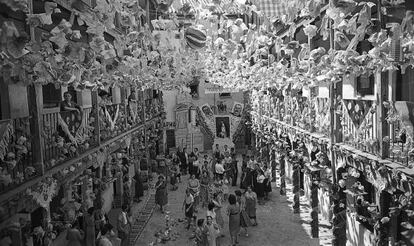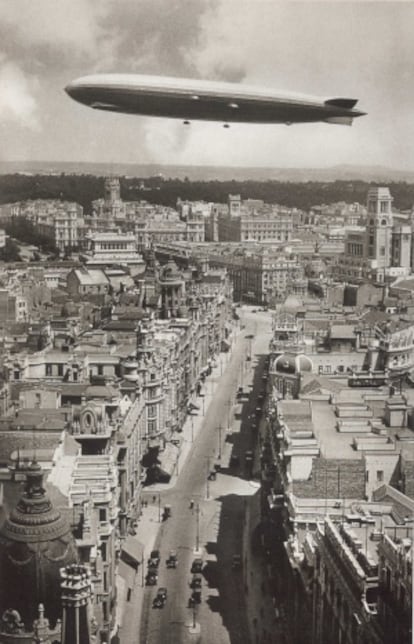Keeping old Madrid alive online
Hundreds of blogs exploring the history of the capital have sprung up in recent years

A photograph of Barajas airport in 1931, soon after it was opened, clocks up 300 retweets. Elsewhere, an internet page dedicated to “Madrid stories” is visited two million time. A Google search on the words Madrid, historia and blog brings up 13 million results. Welcome to the “Madridosphere,” a network of blogs, Facebook pages and Twitter accounts dedicated to rescuing the past of the Spanish capital.
Ricardo Márquez was one of the earliest members of a group that encompasses everyone from amateur historians to those keen to share family secrets, and academics given access to little-known archives. He created his blog, Historias Matritenses (Madrid stories), in 2008. “Back then there were just three or four of us. There are probably around a thousand sites like this now,” he says.
Madrid is made up of legends, but it is important to investigate the sources of the stories to establish the truth” Mercedes Gómez, author of the Arte de Madrid blog
Márquez says he set up his blog to tell stories about his neighborhood. What started as a hobby has become a “serious” job that has led to him publishing three books about the city’s less-well-known corners. “The history of Madrid has been written, but not all of it. This is where blogs come in, which can make a valuable contribution if one is rigorous,” he says. Márquez says it can take several weeks to prepare an entry, many of which are up to 20,000 words long.
Manu García del Moral, author of Secretos de Madrid (Secrets of Madrid), tends to keep his contributions to around 400 words. He started writing in 2012 after moving to the capital from Pamplona to study, and with little idea of the real history of Madrid. “I thought the place was the Puerta del Sol, Cibeles, and Neptune,” he admits. He began writing as he discovered new areas of the city during long walks, and now has around 200,000 followers on Twitter, and another 60,000 on Facebook. His second book has just been published.

“The goal of these pages and initiatives is to keep the history of our cities alive” says García del Moral, adding that in recent months there has been an “explosion” of Facebook and Twitter accounts sharing old photographs of the city. “I was very surprised: I didn’t think there were so many people interested in the history of Madrid. But when you have something interesting to say, and you say it in an interesting way, then it works,” he explains.
Eduardo Valero, the author of a blog called Historia Urbana de Madrid (The urban history of Madrid), believes this growing interest in rediscovering the past is linked to the growth in guided tours. And while some people walk around the city looking for odd spots, or wondering where a certain street got its name from, he prefers to focus on the people who have walked those streets, and on what he calls “real-time history, but from another time.” His writing is always about a news story from the past that he investigates. “I’m no academic,” he admits. “I’m more interested in the human side of stories.”
Valero says the official history of Madrid is often built around stories that have nothing to do with what really happened, such as the widespread belief that the fountain in the central Puerta del Sol square, which was placed there in 1860, was previously located in a nearby street that was demolished, as explained in an entry in Historias Matritenses.
Mercedes Gómez, who has published around 400 pieces on her Arte de Madrid blog since setting it up six years ago, insists that “Madrid is made up of legends, and that is nice, but it is important to investigate the sources of these stories to establish the truth.”
From old cafés to the Madrid that never was
Rosario Giménez has been collecting stories about "those places that nobody seems to care about" – shops, taverns, and above all, cafés. His blog, Antiguos cafés de Madrid y otras cosas de la Villa (Old cafés of Madrid and other things in town), came about through "my curiosity to find out about what is no longer here." His blog is filled with old photographs of streets and places that have long disappeared.
Luis David Zapata says his curiosity is aroused by projects that never made it off the drawing board. He started his page El Madrid que no fue (The Madrid that never was) a year ago. "When I started, it seemed there was nothing left to write about. But I realized that all the blogs talked about the Madrid we know about already, but there is a city that few of us know about, one that was never built, and that is just as interesting," he says.
The stories about Madrid that fill the blogosphere and the social networks all have their inspiration: Anacrónicos (Anachronisms) is focused on the 19th century, and awash with photos; Cines de Madrid explores the forgotten movie houses once found in every neighborhood; while Guerra en Madrid (War in Madrid) tells "the untold stories" about the Civil War in the capital.
But Rafael Martín, author of La muralla reciclada (The recycled wall), says he doesn’t see this as his role. “I’m not looking for academic rigor. I accept myths because I am interested in the idea that cities are made for people. And legends are something alive that people create,” he explains. At 74, he describes himself as belonging to the “pre-information age.” He decided to publish a blog with the material he had left over from the research he carried out while writing a book about Madrid’s old city walls. “People say that Madrid has no history. People from here have never really identified with the city, but in recent years there has been growing interest in knowing about our past,” he says.
While the many blogs about Madrid provide an opportunity to write at length about the capital, Facebook and Twitter have attracted people keen to share photographs of the city, many of them depicting daily life as far back as the beginning of the last century. And while some writers complain that many of the photographs published lack descriptions, García del Moral disagrees: “A photograph is the best witness of what really happened.”
An old image can help you discover the legend that Francis I of France was locked up in the Lujanes Tower, next to Madrid’s former town hall, by Charles V after the Battle of Pavia. It can lead you to take a walk round the Madrid of 19th-century novelist Benito Pérez Galdos, or to travel back in time on public transport. Carlos Osorio, author of Caminando por Madrid (Walking around Madrid), is fascinated by the city’s taverns, and has been writing about them since 2006. He now makes a living from guided tours. “The idea is to take a close look at what is around us. Madrid has a lot of history, it is very rich and diverse. That is what makes it special.”
Tu suscripción se está usando en otro dispositivo
¿Quieres añadir otro usuario a tu suscripción?
Si continúas leyendo en este dispositivo, no se podrá leer en el otro.
FlechaTu suscripción se está usando en otro dispositivo y solo puedes acceder a EL PAÍS desde un dispositivo a la vez.
Si quieres compartir tu cuenta, cambia tu suscripción a la modalidad Premium, así podrás añadir otro usuario. Cada uno accederá con su propia cuenta de email, lo que os permitirá personalizar vuestra experiencia en EL PAÍS.
¿Tienes una suscripción de empresa? Accede aquí para contratar más cuentas.
En el caso de no saber quién está usando tu cuenta, te recomendamos cambiar tu contraseña aquí.
Si decides continuar compartiendo tu cuenta, este mensaje se mostrará en tu dispositivo y en el de la otra persona que está usando tu cuenta de forma indefinida, afectando a tu experiencia de lectura. Puedes consultar aquí los términos y condiciones de la suscripción digital.
Últimas noticias
Maduro pleads not guilty before the federal court in New York: ‘I am still the president of Venezuela’
A new test can detect Alzheimer’s from a finger prick
UN team enters Sudanese city of El Fasher after paramilitary massacre: ‘It’s like a ghost town’
A recipe for resistance: Indigenous peoples politicize their struggles from the kitchen
Most viewed
- Gilles Lipovetsky: ‘If you want to live better and fall in love, take Prozac, don’t look to philosophy’
- Alain Aspect, Nobel laureate in physics: ‘Einstein was so smart that he would have had to recognize quantum entanglement’
- Alvin Hellerstein, a 92-year-old judge appointed by Bill Clinton, to preside over Maduro’s trial in New York
- Why oil has been at the center of Venezuela-US conflicts for decades
- Cuba confirms death of 32 of its citizens in the US attack against Venezuela








































